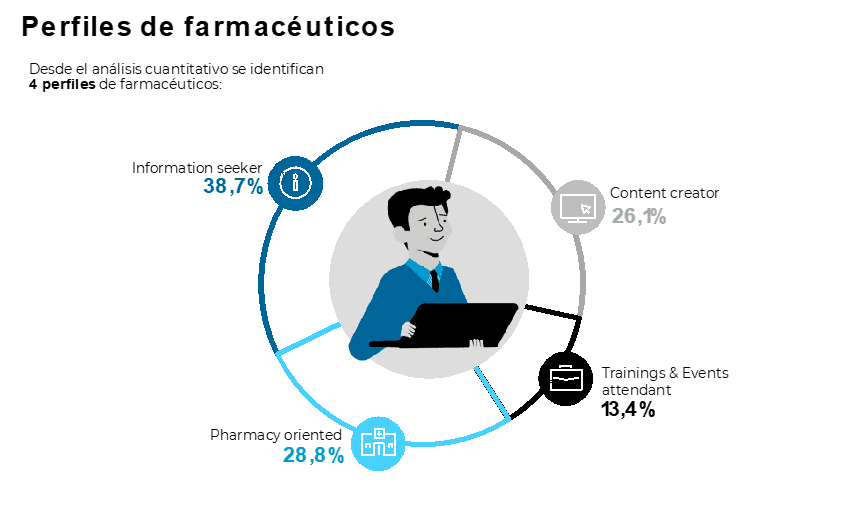Article published in the pharmaceutical management and marketing magazine PMFarma
Digitalization is making its way into the Spanish pharmacy, redefining the interaction with clients and laboratories. Pharmacists are actively adopting digital tools and adapting to the future.
From the emergence of the first digital tools to the consolidation of the information age in which we live, digitalization has transformed the way we operate in practically all aspects of life. Pharmacies, traditionally seen as bastions of personalized attention and face-to-face service, have not remained immune to this phenomenon. In Spain, this transformation has been particularly notable, and the most recent data offers us a fascinating panorama of how this evolution is taking place.
The joint study “Promotional activity in Pharmacies” carried out by Hamilton Global Intelligence in June 2023, is a privileged window to this change. With a significant sample of 311 pharmacists, this study captures a wide variety of experiences, roles, and perspectives.
According to the study, when we investigate the digital profile of pharmacists we see that, for many, the mobile phone has ceased to be a simple communication device and has become an essential work tool. In this sense, the fact that pharmacists use the 67% for their professional activity is not surprising, but it does reveal a notable adaptation to the digital environment. Even more revealing is that an 82% contacts its clients via Whatsapp. This figure reflects not only a change in communication tools, but also in the expectations of customers, who seek more direct, personalized and instant communication.
However, not all digital platforms enjoy the same degree of adoption. Social media, which has transformed the way companies interact with their customers in many sectors, appears to have lower penetration among pharmacists. A 31% of them does not use any social networks, which could be interpreted as a missed opportunity. On the other hand, those who do use them seem to favor Instagram (60%) and, to a lesser extent, Facebook (52%). These platforms offer unique opportunities for health education, promotion of services and products, and establishing a closer relationship with the customer.
The intensity with which pharmacists have immersed themselves in the digital world is reflected in another shocking fact: they dedicate an average of 31.3 hours per week to connecting to the Internet for professional purposes. This figure not only highlights the importance of the network in your daily work, but also the need for adequate training and resources to navigate this environment effectively and safely.
Within their digital practices, 7 out of 10 pharmacists take online courses, which underlines the importance of continuous training in a constantly evolving field such as pharmacy. The ability to update your knowledge, learn about new medicines or techniques, and share experiences with colleagues around the world is one of the great advantages that digitalization offers.
E-commerce gains ground in the pharmaceutical sector
At the same time, electronic commerce has gained ground in the pharmaceutical sector. According to the report, almost a third of pharmacists already sell products over the internet. Although online sales represent only 6% of the total volume, it is evident that the web is beginning to play an important role in the sales strategy of pharmacies. Among these digital pioneers, more than half have chosen to use their own websites, while a close percentage have decided to partner with already established groups, among which Promofarma, Fmaonline and Sensa Farma lead the market.
This phenomenon not only opens a new sales channel for pharmacies, but also highlights the importance of having an online presence that is authentic and reflects the identity of the pharmacy, maintaining the trust and personalization that customers expect.
The key influencers for professionals are “Farmacia enfurecida”, “Pharmacists in general” and “Boticaria Garcia”
In the world of social media, influencers are playing an increasingly crucial role in shaping opinions and trends within the pharmaceutical profession. It is notable that more than half of professionals follow influencers related to their field, and among them, «Farmacia enfurecida”, “Pharmacists in general” and “Boticaria Garcia” have established themselves as key references. This shows that pharmacists are looking for voices that can translate the complexity of the industry into a more accessible and relatable format.
The digitalization of the relationship between pharmacists and laboratories is already a notable emerging trend. The study has shed light on this transition, indicating that one in three pharmacists now receives virtual visits from laboratory representatives, marking an increase of more than 10% compared to the figure we saw in the previous edition of the study in 2021. This This figure not only reflects an adaptation to the digital age, but also raises questions about the future of personal interaction in the sector.
The increase in virtualization of pharmacy visits is a clear sign that the industry is finding value in digital tools, which allow for greater flexibility and efficiency. Although still in its early stages, digitalization offers a space for pharmacists to access information and support from laboratories more conveniently and quickly.
However, not everything in the digital world is positive. Despite improvements in satisfaction with OTC laboratory activities since 2021, there are still 63% pharmacists who are dissatisfied. Areas for improvement focus on training, courses and webinars, as well as presence and strategy on social networks. The laboratories' digital communication has maintained an average rating of 5.1 out of 10, indicating that there is considerable room for development and improvement, especially with regard to the relevance and frequency of digital content.
The perception of the support of laboratories in the digitalization process of pharmacies varies. Although the effort on the part of some is recognized, it is clear that the most used digital tools are the Digital portal and the materials for social networks provided by the laboratories.
This year's study on digitalization in the pharmaceutical field not only highlights changes in the relationship between pharmacists and laboratories, but also identifies four different profiles of pharmacists based on their interaction with digital tools, each with its characteristics and modes. to integrate technology into their professional practice.
The first group, known as "Information seeker", constitutes 39% of the total and is characterized by its intensive use of the digital environment mainly for consulting information, news and monitoring influencers. However, their communication is more limited. These professionals usually work in smaller pharmacies and have a more loyal clientele. Despite their preference for consultation, they have also taken steps towards online sales, adapting to new market demands.
The second profile is the “Pharmacy oriented”, which represents the 29% of pharmacists. This segment shows a high use of digital environments but with more basic interactions, focused mainly on management and communication with the client. Neighborhood pharmacies predominate in this group and, although they have more restricted opening hours, they use tools such as WhatsApp to maintain contact with their customers.
The third group, the "Content creators", includes 26% and stands out for being the oldest and the one with the highest level of online activity. These pharmacists make use of a variety of devices and social networks to not only consume content, but also create and publish their own, offering a unique and personal perspective to their followers.
Finally, we find the "Trainings & events attendants", who represent the 13% of pharmacists. This segment is the youngest and is more inclined to comment and share content than to create it. They are usually associated with larger pharmacies, with a larger number of employees and with a more varied and sporadic customer profile.
Incorporating these typologies into our analysis allows us to better understand how different pharmacist profiles are navigating the wave of digitalization. The presence of these heterogeneous profiles is a testament to the diversity within the profession and how each pharmacist adapts and contributes to digital evolution in their own way.
With these profiles in mind, it is imperative that laboratories and online sales platforms recognize and adapt to the varied needs of pharmacists. Digital tools and strategies must be flexible enough to satisfy everyone from the “Information seeker” who seeks reliable data, to the “Content creator” who needs a platform to share their knowledge and experiences.
In conclusion, we are witnessing a time of transformation in which the traditional neighborhood pharmacy finds itself at the crossroads of digital innovation.
It is a critical time for laboratories and pharmacies to not only adopt technology, but also integrate it in ways that improve the customer experience and strengthen pharmacy practice. The key to success will be finding a balance between maintaining the essence of personalized attention and taking advantage of the advantages of digitalization.
Furthermore, digitization is not a uniform process, but one that is rich in nuance and variety. The industry must not only offer technological solutions, but also cultivate an inclusive and accessible digital environment that respects and enhances the individuality of each pharmacist and their pharmacy.
Clara Matamala
Head of Sales at Hamilton Global Intelligence
December, 2023




